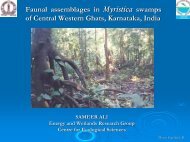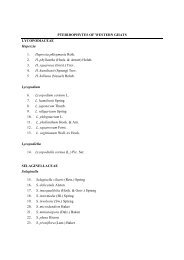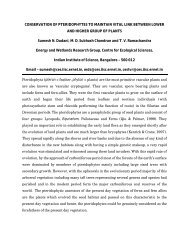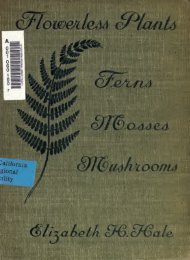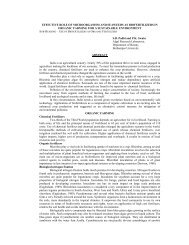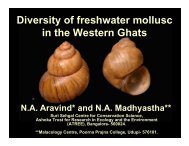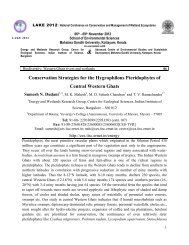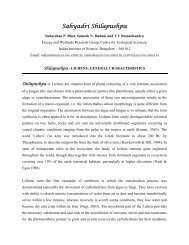regional wood energy development programme in asia ... - CES (IISc)
regional wood energy development programme in asia ... - CES (IISc)
regional wood energy development programme in asia ... - CES (IISc)
You also want an ePaper? Increase the reach of your titles
YUMPU automatically turns print PDFs into web optimized ePapers that Google loves.
In 1983-84 the National Forest Survey and Inventory of Myanmar (NFSIM) carried out an<br />
<strong>in</strong>ventory of 7 forest reserves which are also designated as <strong>wood</strong>fuel supply areas. The <strong>in</strong>ventory<br />
covered an area of 99,964 acres. In total, 123 different tree species and 7 bamboo species were<br />
recorded <strong>in</strong> the area. The groups of the different tree species recorded <strong>in</strong> the survey are given <strong>in</strong><br />
Annex VI while the stand<strong>in</strong>g stock of trees and bamboos <strong>in</strong> the area are shown <strong>in</strong> tables 7.4 and<br />
7.5. However, not all of the species are used as <strong>wood</strong>fuel as already po<strong>in</strong>ted out <strong>in</strong> chapter 3 (with<br />
a list of fuel<strong>wood</strong> species shown <strong>in</strong> Annex 1). The same is valid for bamboo where only 3 out of<br />
the 7 specie; hmy<strong>in</strong>, thaik and wanwe are used as fuel, ma<strong>in</strong>ly for evaporated milk production.<br />
Table 7.4 Grow<strong>in</strong>g stock of trees <strong>in</strong> the study area.<br />
Group<br />
0<br />
1<br />
2<br />
3<br />
4<br />
5<br />
6<br />
Girth (GBH) classes (<strong>in</strong> feet and <strong>in</strong>ches)<br />
2'-2' 11" 3' and over Total 2'-2' 11" 3' and over Total<br />
91,675<br />
450,613<br />
419,041<br />
114,140<br />
32,354<br />
34,150<br />
318,375<br />
Number of trees Quantity <strong>in</strong> stacked tons<br />
89,316<br />
545,448<br />
440,513<br />
186,432<br />
84,106<br />
33,814<br />
403,188<br />
180,991<br />
996,061<br />
859,554<br />
300,572<br />
116,460<br />
67,964<br />
784,563<br />
37<br />
22,716<br />
81,852<br />
89,028<br />
22,135<br />
6,360<br />
6,768<br />
69,620<br />
49,210<br />
245,973<br />
192,678<br />
77,006<br />
55,409<br />
17,107<br />
194,654<br />
71,926<br />
327,825<br />
281,706<br />
99,141<br />
71,769<br />
23,875<br />
264,274<br />
1,523,348 1,782,817 3,306,165 298,479 832,037 1,130,516<br />
On an area of close to 100,000 acres, the total stand<strong>in</strong>g stock was over 3.3 million trees<br />
with diameters of over 2 feet. The total volume was about 1.13 million stacked tons. Out of this,<br />
close to 1 million trees (or equivalent to 0.35 million stacked tons) consisted of fuel<strong>wood</strong> species.<br />
The density of trees identified as fuel<strong>wood</strong> species with diameters of over 2 feet, would then be<br />
about 10 trees per acre with a weighted volume of about 3.5 stacked tons.<br />
For the total area classified as <strong>wood</strong>fuel reserve <strong>in</strong> the study area which covers about<br />
61,500 acres (see table 2.1),the total amount of stand<strong>in</strong>g stock of fuel<strong>wood</strong> species would then be<br />
about 61,500 acres x 3.5 stacked tons or 215,250 stacked tons. This is equivalent to about 16.5<br />
times higher than the average annual extraction target, of 13,125 stacked tons, over the last 5<br />
years. However, fuel<strong>wood</strong> trees with diameters below 2 feet, have been excluded.



